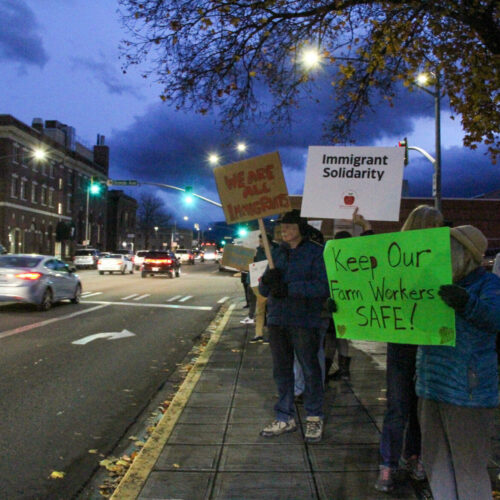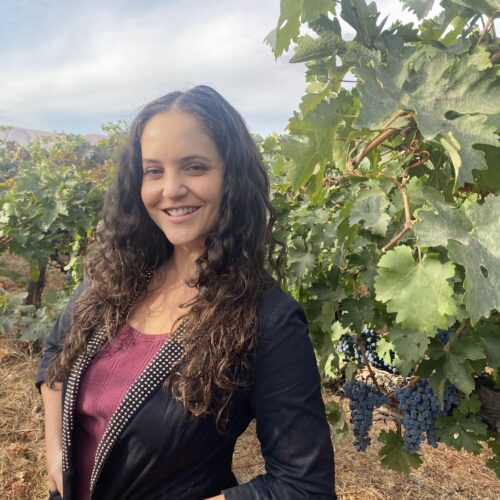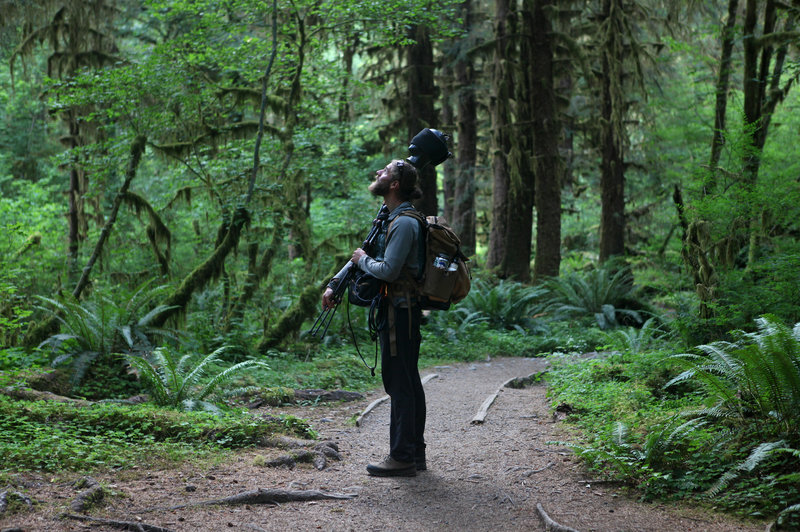
Listening For The Sound Of Silence In Washington’s Hoh Rain Forest
Listen
BY SAMIR S. PATEL
Summertime is for road trips. Atlas Obscura and All Things Considered are traveling up the West Coast, from California to Washington, in search of “hidden wonders” — unique but overlooked people and places. See the full series here.
It’s a little before 5:00 on a summer morning, and Matt Mikkelsen stands not so far down a trail in the Hoh Rain Forest in Washington’s Olympic National Park. In the dense forest, dominated by massive Sitka spruce trees dripping with tangles of moss, Mikkelsen has just set up a tripod, topped not with a camera but with a disembodied black foam head.
The head is actually an unusual microphone — which Mikkelsen lovingly refers to as “Fritz” — and he is using it to record the dawn chorus, the time when the forest wakes, and the chirps and hiccups of the night give way to the trilling, ecstatic reveille of the rain forest’s birds. (To fully experience what this sounds like, listen to the audio version of this story — available above — using earbuds.)
Mikkelsen, an audio technician and recording specialist, works with a nonprofit called One Square Inch of Silence, founded by his mentor, audio ecologist Gordon Hempton. Its purpose is to promote the preservation of quiet places — that is, places without human-made sounds.
Protecting wilderness, they argue, means more than guarding against development and industry, but also keeping spaces free of noise pollution — including the sound of aircraft far overhead — that can affect the people who visit these places and the wildlife that calls them home.
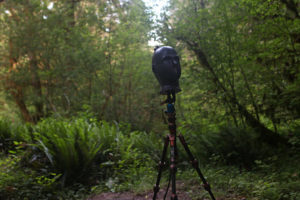
Fritz, the microphone system used by Mikkelsen and his mentor, audio ecologist Gordon Hempton, stands on a tripod. They use their recordings to promote the idea that natural sounds are complex, diverse and important. CREDIT: SAMIR S. PATEL
In 2005, when Hempton founded One Square Inch of Silence, he designated a spot, a few miles up the Hoh River Trail into the rain forest, the quietest place in the U.S. and marked it with a small, red stone.
Mikkelsen, 24, is tall and slim, with a long auburn beard. His friends call him “Sasquatch,” but that doesn’t seem to suit his gentle, quiet demeanor.
“Even though protecting 1 square inch seems like a very small, insignificant amount of space,” he explains, “due to the nature of sound and silence, it’s preserving this whole ecosystem.”
If that inch stays quiet, that means that the entire valley, and miles around it, will be similarly intact and free of intrusive noise. Hempton defines a naturally quiet place as one where there are 15 minutes of non-human-made sound. He estimates that there are fewer than 10 such places in the U.S.
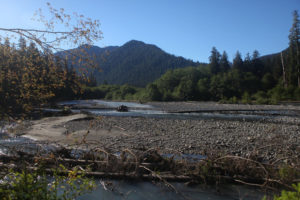
Near Hoh River Trail in Washington state’s Olympic National Park. CREDIT: SAMIR S. PATEL
As Mikkelsen adjusts the sensitivity of his recording, the dawn chorus seems to explode around the valley.
“In a forest like this, it’s so dense, I can only see maybe 50 yards in one direction, if you’re lucky,” he says. “But I can hear for miles.”
That sense, of how far you can hear, is known as your auditory horizon, and much of the time — indoors or in a city, for example — it doesn’t extend very far. But in the forest, with eyes closed and a little focus, it sprawls.
“In a place like this your auditory horizon isn’t just 1 or 2 miles,” he says. “You can hear everything that’s happening in this valley. … It’s like we’re listening to 5 miles or 10 miles around us right now. It’s crazy.”
Mikkelsen then offers headphones connected to Fritz, so visitors can hear what Fritz’s hypersensitive ears are picking up. The sensation is more than mere amplification, because you can still perceive the direction and distance of each twitter and rustle, thanks to Fritz’s ears.
“When you listen to it through a microphone system like this,” he says, “you all of a sudden realize that you’re listening to hundreds, if not thousands, of birds.”
It’s like your own hearing, enhanced to an impossibly intimate level.
But since One Square Inch of Silence was established, the Hoh Rain Forest has gotten louder, through increased air traffic and the testing of loud Navy jets nearby.
Now, Hempton and Mikkelsen are planning to make One Square Inch part of a larger effort to identify, designate and protect quiet places like it around the world.
“Just the fact that this place exists is enough to give me hope for the world,” Mikkelsen says, softly. “And I think that’s the reason why we conserve wilderness in the first place.”
Samir S. Patel is deputy editor of Atlas Obscura.
Maureen Pao edited the web story. Dylan Thuras, a founder of Atlas Obscura, Matt Ozug, Renita Jablonski and Michael May reported, produced and edited the audio story.
Related Stories:
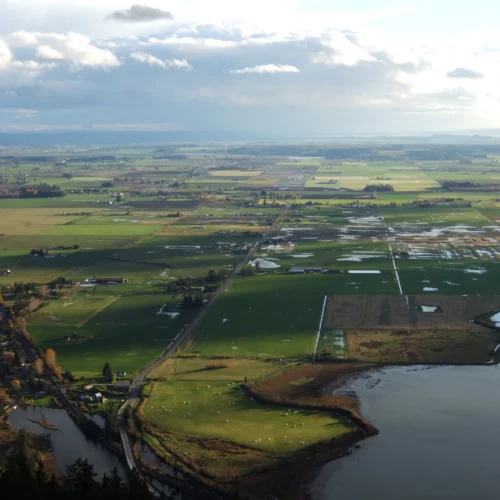
Lawmaker proposes ban to keep foreign entities from buying Washington forest and farmland
Legislators in Washington state are joining more than a dozen other states that are considering whether to restrict or ban foreign entities from buying farmland. The initial hearing on Olympia’s version of the foreign ownership restrictions however drew more criticism than support on Tuesday.
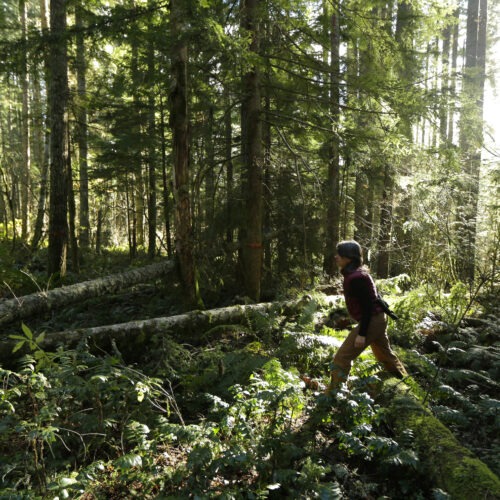
“Prepare For Higher Than Average Fire Season,” Says Washington Forest Protection Association
Paula Swedeen, a forest policy specialist for the Washington Environmental Council, walks through forest land adjacent to Mount Rainier National Park. (AP Photo/Ted S. Warren) Listen Reporter Lauren Paterson tells
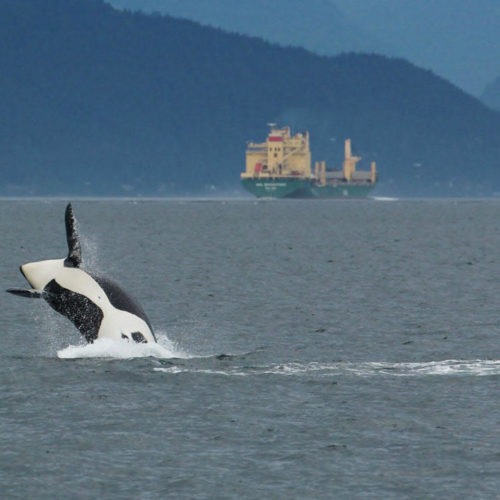
Pandemic Gives Pacific Northwest Whales A Respite From Din Of Underwater Noise
American and Canadian marine scientists — and one talented dog — are seizing an unexpected opportunity presented by the coronavirus pandemic. They are trying to establish whether Pacifc Northwest whales benefit from the current drop in boat traffic and underwater noise.


